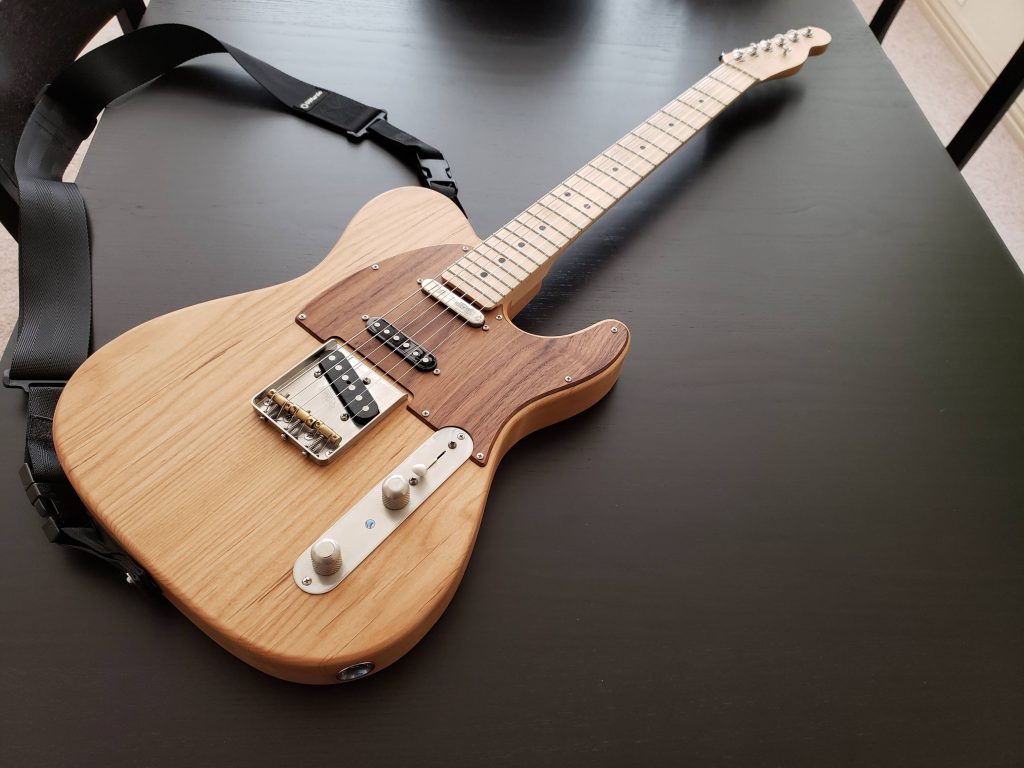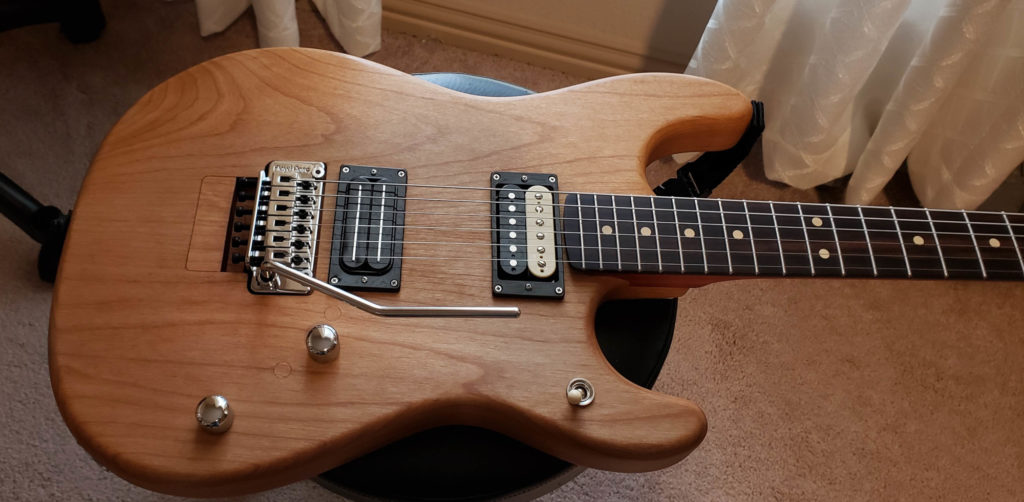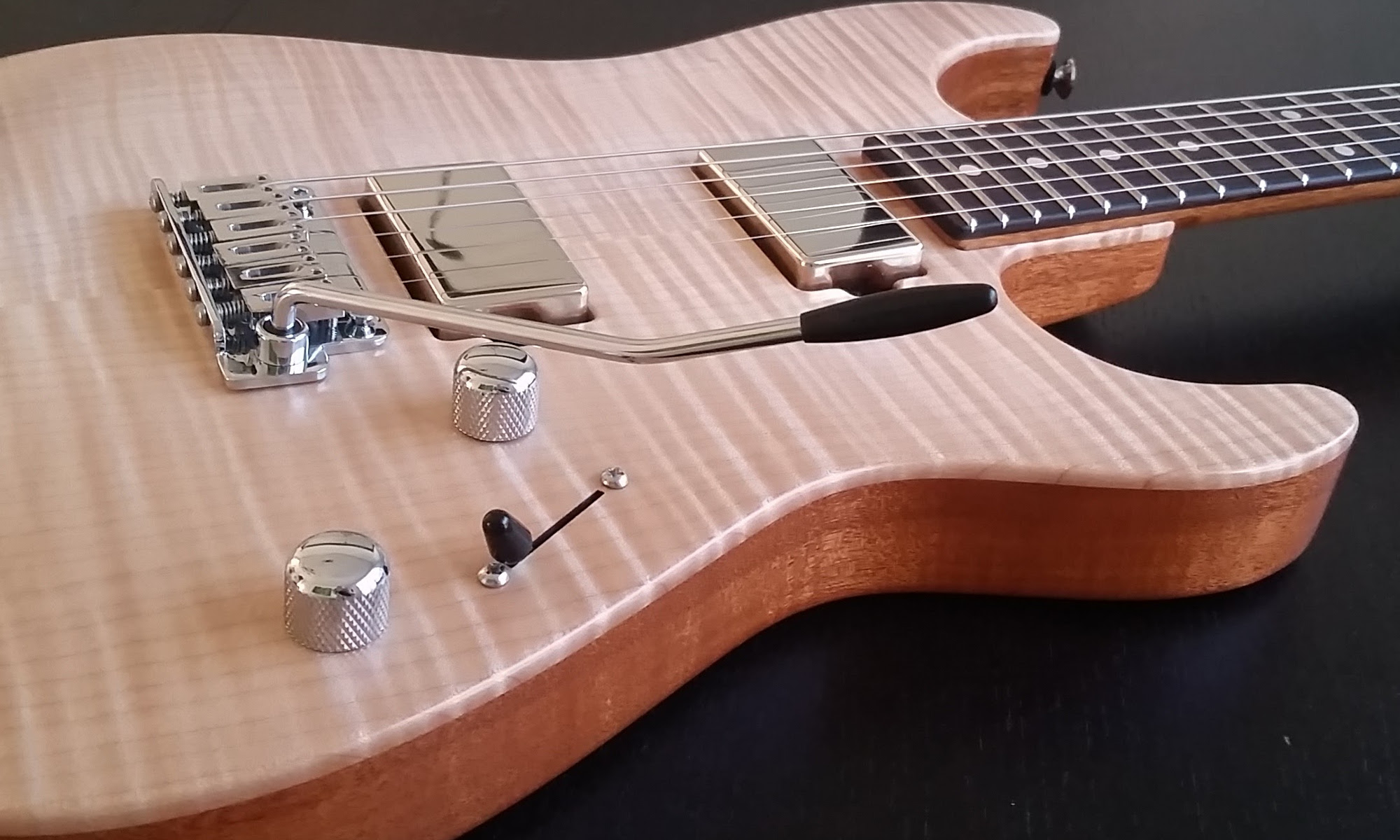
I’m going to share my thoughts and opinions for how I get the most value with a Warmoth parts guitar. This isn’t necessarily a how to save money post, although I’ll inlcude some thoughts along those lines as well. I’ve been really happy with my Warmoth builds and it’s my hope that some of you will find my thoughts helpful. Enjoy!
Begin with a purpose or solve a problem
If you spec out an instrument w/o a purpose or a problem to solve, then you’re much more likely to end up dissatisfied with the results. Specs, regardless of how nice they look on paper, need to become something with meaning. Building your “dream guitar” is not enough to define this. Here are the high-level examples I used to target previous builds:
- A telecaster that can nail all the classic tones and be versatile enough to cover country, jazz, blues, & rock.
- A vintage-style strat that’s quiet and has a functional tremolo that doesn’t grind into my palm and stays in tune.
- A shredder guitar capable of convincing heavy tones ranging from rock to metal. This guitar must “chug” when I need to and have a floyd rose because I want one guitar with a floyd.
- A modern 5-string bass for recording that can span as many genres as possible.
Basically start with the end state that you’re looking for and work backwards. While this doesn’t mean you’ll be perfectly satisfied with the results, it will provide a goal or hopefully some guardrails to help you along the way. After the build is done, your instrument should now be useful in solving a need you had when you started the project, and ultimately spend less time collecting dust in a case.
Almost 10 years ago I got an itch for a strat in a bad way. I was in Los Angeles on a work trip, driving down the highway and blaring the Red Hot Chilli Peppers’ BSSM. As I listened to John Frusciante’s playing I thought I have got to get a strat that can recreate this. That was the seed that inspired me to get my white strat, and I still love having an instrument with that vibe and tone. I haven’t wanted another strat since.
Know when to follow your preferences and when to diverge
I’m at the point in my life where I value diversity in my collection of guitars. Different instruments can bring out different aspects in your playing and this can really aid the music you create. Tim Pierce often talks about this on his Youtube channel. So if variety is the spice of life, then why not spice up your guitars and try things you don’t normally gravitate towards? I have strong preferences in certain areas, but sometimes it’s nice to get away from those, e.g.
| I love | …but sometimes |
| Maple necks and fingerboards | rosewood & ebony feel and sound so good |
| 2-post floating tremolos | a fixed bridge is just better |
| vintage output pickups | higher output pickups are what’s needed |
| thicker necks | thin necks let me play faster and are comfortable |
Naturally the question then becomes, when do I do stick to my defaults vs something different? This is where rule number one comes in and having a purpose will help you make the right choice regardless of what you normally gravitate towards.
Spend money on what matters most to you
Chances are you probably have a budget for the project you’re planning. Assuming that’s the case, you need to meet your goals without sacrificing on things that matter to you. If you cut corners on things you care about, no matter how small, you’ll regret it in the long run. Do it right, not fast. There’s no shame in lengthening the time to complete a project so it can be funded appropriately.
For me, I cannot stand cheap guitar hardware. Life is simply too short to tolerate bad hardware. So I know going into a build that I’m not going to skimp on this area because that would impact my enjoyment of the guitar. I also care a lot about what the wood and what the grain looks like. I love that Warmoth will show me the exact piece in their showcase before I purchase it. If I’m able to buy from there, I never have to worry about getting a piece that I don’t care for or other aesthetic issues. I’m not going to skimp on wood or hardware for my builds, but it’s completely fine if your preferences lead you down a different path.
Experimentation, worth the risk?
Maybe, but only if you’re being responsible. This is a topic that Aaron Cheney from Warmoth talks about in some of his interviews. He makes that point that users probably shouldn’t stray too far from tried and true combinations. In general, I couldn’t agree more. Most of the well known formulas of wood species and pickup types are popular because they’re so good.
With that said, if you’ve been playing for a while and really know what you like as a player, then I think you can be successful with some reasonable experimentation, assuming it serves the previous points in this post: Will it help you meet your goal? Will this add a new element to your collection that will inspire you? If you have a strong hypothesis of what the outcome will be, then there’s plenty to be gained from trying something new. Worst case, if the experiment doesn’t workout you may have to resell the part(s) in question and purchase something different. Make peace with that before you buy and you’ll be fine.
Two things that worked out really well for me was 1) getting a fat-back neck on my strat. I wouldn’t want more than one, but I’m very glad I chose that this particular guitar. 2) trying a Padouk neck. I didn’t know how well this would pair up w/ an Alder body, but I took a chance and it’s one of my favorite guitars. I consider both of these pretty responsible experiments that’s worked out really well in my favor.
Go with your gut and don’t overthink it
Gear and specs are a never ending rabbit hole. You do not need to spend tons of hours researching on youtube and the gear page. I think you’ll learn more about your preferences by trying different guitars than you will by watching videos or reading about them. Feel is important, let your hands guide you and get what works for your hands. Hear with your ears, not your eyes. We’re all guilty of screwing this up at times, but stay open minded even if what you like goes against what the marjority does.
Also remember that your preferences will evolve over time. I continue to adapt and modify my guitars so they continue to suite my needs. So even if you could learn everything there is to know on the internet, your preferences would change many times during that process. …so remember don’t overthink it!
My formula
I find I get the best results for my preferences AND save a substantial amount of money by doing the finish work myself. Natural oil finishes are not for everyone, but I really like the look and feel of raw wood. If you need to save some $$ on your project, the finish is the easiest thing to drop that will not impact the quality of the components. While neck finishes are approximately $100, body finishes can range between $175-275 depending on options. That’s not a bad price to pay for finish work if that’s what you’re after, but since it doesn’t align w/ what I like, I’d rather save the ~$300.
OK so with all that throat clearing, here are the breakdowns of my last two Warmoth projects. These are both far more valuable to me than the cost of parts of labor I put into them. A lot of that has to do with the face that I started with the “why” before I defined the “what”. There are previous posts if you want to see more details on the build process.

| Nashville Tele Parts | Cost |
| 2 piece alder body | $175.00 |
| maple neck w/ stainless frets | $207.00 |
| neck screws | $2.60 |
| ferrules | $5.04 |
| string tree | $2.00 |
| gotoh locking tuners | $75.00 |
| gotoh bridge | $55.00 |
| pickguard | $70.00 |
| pickups | $200.00 |
| 2-pole 5-way | $10.00 |
| control & neck plate | $17.00 |
| pots | $8.18 |
| strap | $24.00 |
| Jack | $12.00 |
| Total | $862.82 |

| N4-ish Super Strat | Cost |
| 2 piece alder body | $215.00 |
| Paduak Neck w/ Stainless frets | $285.00 |
| neck screws | $2.60 |
| Floyd studs | $12.00 |
| NFT Floyd | $150.00 |
| Anderson locking Tuners | $90.00 |
| pickups | $145.00 |
| 3-way toggle | $10.00 |
| neck plate | $5.00 |
| pots | $10.00 |
| strap | $24.00 |
| Jack | $12.00 |
| Total | $960.60 |
Anyway, partscasters aren’t not for everyone and that’s ok. For me, I’m able to get exactly what I want at a much lower price point. I still cannot believe the two guitars above cost less than $1,000. They can easily hang with other $2k -$4k guitars that I own. That is an exceptional value IMO and better yet, they solve a problem space that my other guitars can’t. I hope this is useful for others. Cheers and good luck!
Update!! What if the build sucks?!
Maybe sucks is too strong of a word here. What I’ve found is a more likely scenario is that we often confuse *new* with *good*. It can take time and perspective for issues to show. A great example is the tele pictured above. It was pretty good at first, but cracks started to show after a few months. I got lucky with the strat pictured above, it had tons of mojo out of the box and now years later, it’s still just incredible.
So first thing is to figure out if there is a functional issue, e.g. bad setup, high fret(s), etc. Things like this are almost always solvable and may or may not require a tech to fix properly. I recommend knocking out all the functional issues as a first step. A single high fret has the potential to wreck and otherwise incredible instrument. Solve these first.
The harder aspect is what to do when the instrument is perfectly fine, but kinda a dud. I always describe this as a guitar w/o mojo, but that doesn’t really help diagnose or make it quantifiable. Where I’m at right now with writing this is that some parts are just duds, and certain combinations will lead to poor results. Maybe it’s the piece of wood, maybe the employees involved had a bad day, who knows. The why is not as important as the result. How to solve this becomes the trap of the partscaster: trial and error.
Here’s what I did w/ the tele above. I wasn’t happy w/ the fret job on the original neck. I leveled and crowned them, but ……it still wasn’t great. I decided to try a different neck. I got a roasted maple one as it doesn’t require a finish. Unfortunately this neck also had a number of high frets on it. I should point out that most replacement necks are sold with the expectation that the frets will be leveled after purchase/installation. I decided to have this one PLEK’ed. I don’t remember the exact price, but it was probably another ~$500 give or take for the cost of the neck and plek job.

Hey Ben
One of my friends here in Colorado has your blue Ben Screamer pedal.
He really loves it but it apparently just stopped working.
I do a lot of guitar work (tech and building) so he asked me to look at it. This is not my area of expertise so I found your site online and figured I would give you a message.
Would you be willing to take a look at it and maybe try to make it work again?
Please let me know.
Thank you
Lance
lookslikemeband@yahoo.com
Wow, it’s a small world. I think that pedal sold for close to $20 on ebay. That sucks that it’s having issues. I would start by checking that the board isn’t shorting on the back of the case. Then make sure the main footswitch is still good – those are natorious for failing. After that, assuming all the wires look ok I would start tracing the board. Worst case we could always just get a new kit from GGG and use those parts.
Great article on Parts casters. I am building a strat to help my inner rock God shred God stuff. 🤣. It doesn’t have a Floyd, but I have guitars with Floyd’s and I wanted to use a fender trem. I’m going to do a lot of blues based hard rock with this guitar and so I used the Mexican body I had which isn’t pretty, but it’s fine. I don’t subscribe to the wood helps tone. Wood is dead. It’s the pickups, nut, bridge and strings and ones playing that makes up tone.
So, I purchased a strat pickguard with an EMG 85 for the bridge and a 60 for the neck. I hate hiss and hum. I also like to drive amps and pedals and make them work hard. It gives me that feel a d I can ride the volume knob for leads and soft parts and not need a bunch of pedals.
The neck I ordered from warmoth is a maple quartersawn 22 fret with jumbo 6100 stainless frets. I’m using staggered tuners and no strings tree and an upgraded strat stainless steel parts six screw trem with a big block all steel trem block. It seems to help sustain a little.
Once I get it all together I can’t wait to try it. I injured myself and haven’t been able to play for two months and I’m going mad. 🤣. Just one more month.
Great article sir..
Thanks
Regards from South Central Indiana… USA.
Tim